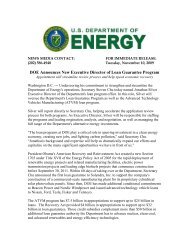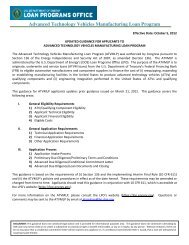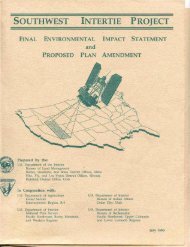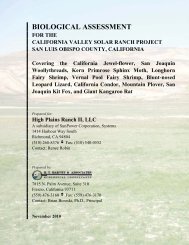Bureau of Land Management's Decision Record and Environmental
Bureau of Land Management's Decision Record and Environmental
Bureau of Land Management's Decision Record and Environmental
You also want an ePaper? Increase the reach of your titles
YUMPU automatically turns print PDFs into web optimized ePapers that Google loves.
Attachment E<br />
CONDITIONS OF APPROVAL FOR GEOTHERMAL UTILIZATION<br />
Stipulations Unique to Lease NVN-77483<br />
BLM WINNEMUCCA FIELD OFFICE GEOTHERMAL LEASE STIPULATION FOR<br />
BATS<br />
Two species <strong>of</strong> bats, the Pallid bat (Antrozous pallidus) <strong>and</strong> Townsend’s big-eared bat<br />
(Corynorhinus townsendii) use adits located within secs. 27 <strong>and</strong> 34, T. 27 N., R. 40 E., MOM,<br />
Nevada. The lease will be subject to the following protection measures:<br />
a) The No Surface Occupancy restriction will apply to a 0.25-mile radius around the openings <strong>of</strong><br />
adits occupied by these bats.<br />
b) Caution should be used to avoid coming in contact with any <strong>of</strong> the adits during drilling.<br />
c) Personnel should be cautioned to avoid entering the 0.25-mile radius around the openings <strong>of</strong><br />
adits occupied by these bats.<br />
BLM WINNEMUCCA FIELD OFFICE GEOTHERMAL LEASE STIPULATIONS<br />
Noncompetitive areas <strong>and</strong> all Known Geothermal Resource Areas (KGRA) will be open to<br />
geothermal leasing with the following restrictions:<br />
Sage grouse: The following stipulations apply to protect sage grouse <strong>and</strong> their habitat. Known<br />
habitat is defined as those areas where sage grouse have been observed. Potential habitat is an<br />
area where sage grouse may occur. Known Breeding habitat <strong>and</strong> Leks: February through June,<br />
but may vary on site specific basis. Avoid all activity within 3.3 km. (2 miles) <strong>of</strong> known leks<br />
during the mating season -<br />
Personnel. No surface occupancy within 3.3 km (2 miles) <strong>of</strong> known leks at all times. Nesting<br />
March<br />
through May, or as determined by Field Office <strong>and</strong> Wildlife<br />
Habitat <strong>and</strong> Brood-rearing habitats: (April through August per Interim NY Guidelines) <strong>and</strong><br />
Winter Habitats: (October through March). Known Habitat: Avoid all development or<br />
exploration activities within 3.3 km (2 miles) or other appropriate distance based on site-specific<br />
conditions, <strong>of</strong> leks or within 1 km (0.6 mi.) <strong>of</strong> known nesting brood-rearing <strong>and</strong> winter habitat.<br />
Potential Habitat: Avoid permanent occupancy <strong>of</strong> potential habitat.<br />
General Sage Grouse Stipulations:<br />
Prior to entry on any lease areas which include known or potential habitat, the lessee (operator)<br />
shall contact the appropriate BLM Field Office to discuss any proposed activities. Controlled Or<br />
Limited Surface Use: (avoidance <strong>and</strong>/or required mitigation measures to be developed) -<br />
applicable for all leases proposed in areas <strong>of</strong> crucial deer, antelope, <strong>and</strong> big horn sheep habitat<br />
during migration <strong>and</strong> critical fawning <strong>and</strong> kidding areas.<br />
Other B iota: Prior to site development, a survey for invertebrates will be conducted on areas<br />
where geothermal surface expressions occur.<br />
9<br />
Are







